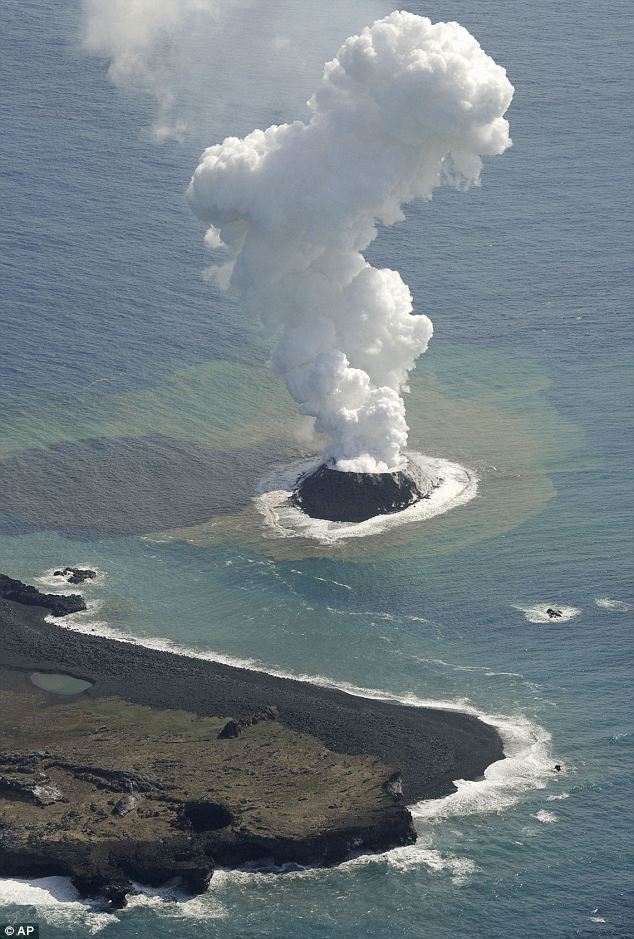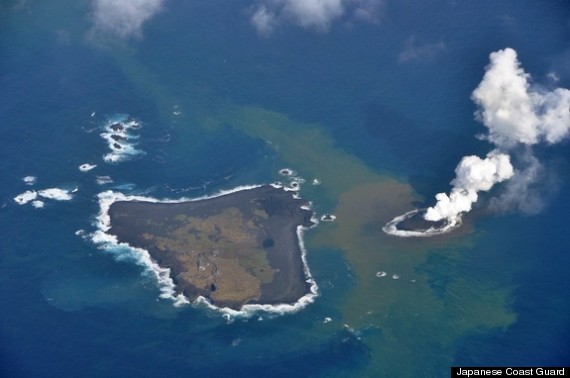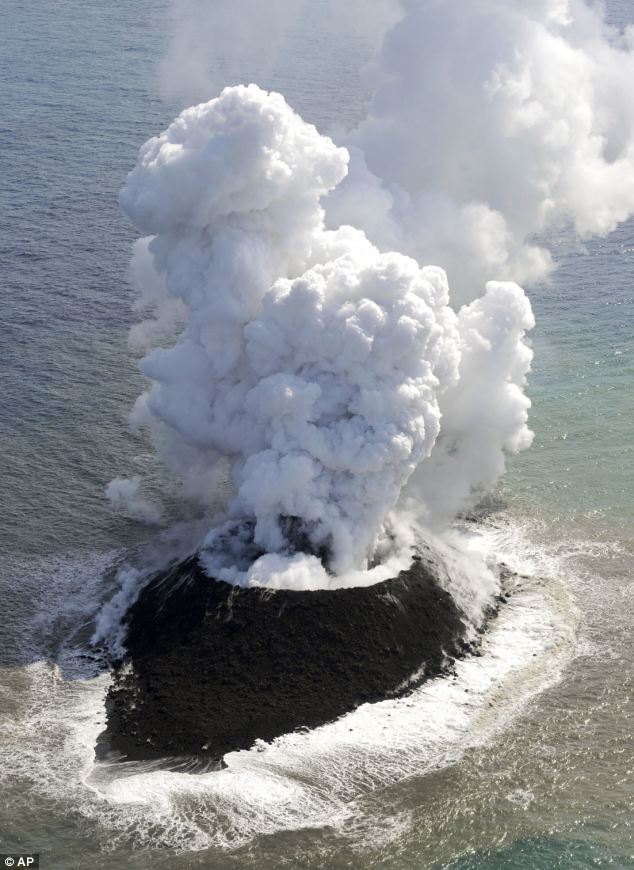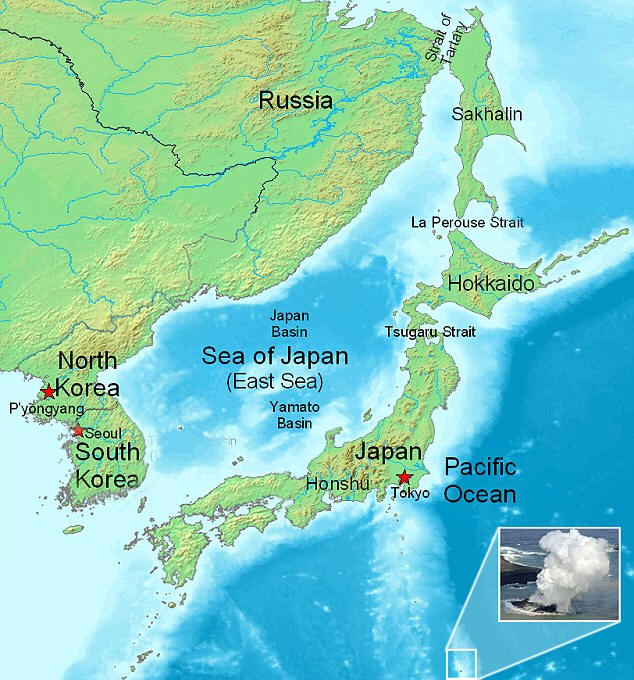

NEW ISLAND OFF OF JAPAN
NEXT TO THE ISLAND OF NISHIOMO
Smoke billows from a new islet off the coast of Nishinoshima,
a small, uninhabited island in the Ogasawara chain off the coast of Tokyo.
The Japanese coastguard and earthquake experts said a volcanic eruption
raised the new island in to the seas on Wednesday. It is around 600ft in
diameter
Dee Finney's blog
start date July 20, 2011
today's date November 25, 2013
updated February 2, 2014
page 600
ISLAND BLOWS UP AND SWALLOWS THE FIRST ISLAND.
As a seafloor volcano continues to erupt in a remote part of the Pacific Ocean, a newborn island has swallowed its neighbor whole, images from space show.
In November 2013, a baby volcanic island rose from the sea out of a volcanic blast in the Bonin Islands about 620 miles (1,000 kilometers) south of Tokyo, on the western edge of the Pacific "Ring of Fire," a hotbed of seismic activity. Named Niijima, the newcomer boiled the sea and spewed steam, ash and lava fragments into the air.
Some thought the small black cone — which sprouted just offshore of a larger volcanic island called Nishino-shima — might slip back into the sea, vanishing under pounding waves. But Niijima kept growing

A new volcanic island, called Niijima, emerged from the ocean on Nov. 20, 2013.
Now a satellite image taken March 30, 2014, by the Operational Land Imager on Landsat 8 shows that Niijima has actually overtaken Nishino-shima.
Together, the conjoined islands measure about 3,280 feet (1,000 meters) across, officials with NASA's Earth Observatory said. The landmass has also tripled in height since December, now rising more than 196 feet (60 m) above sea level.
The smashed-together islands mark the top of a giant submarine volcano that had not erupted since a major outpouring in 1973 to 1974, according to the JapaneseCoast Guard. Lava flows are now most active in the southern portion of the new landmass, and plumes of ash continue to rise, with tiny particles seeding a stream of white cloud puffs overhead.
"The intermittent, pulsing shape of the cloud stream might be a reflection of the volcanic eruption itself," officials with NASA's Earth Observatory wrote. "Strombolian explosions are essentially bubbles of lava and gas rising from Earth's interior in pulses. Underwater, sediment appears to be stirred up in a green plume that stretches eastward from the island."
Nishinoshima
(Ogasawara) - Wikipedia, the free encyclopedia
Continuing
Eruption at Nishinoshima Joins Two Islands | Science ...
Japan's
Newest Island Is Now Eight Times Bigger
Watch
a New Island Sprout From a Pacific Volcano - Slate
A
New Island Off The Japanese Coast Is Growing Like Crazy
New
Japan island: Volcanic eruption builds new island in Pacific ...
Volcanic
eruption in the Pacific Ocean creates a new island off the ...
Volcanic
eruption raises new island in Pacific's 'Ring of Fire' - NBC ...
Eruption
at Nishino-shima in the Pacific Produces a New Island ...
Volcano
Eruption Creates New Island In Pacific Ocean [Photos]
Volcanic
Eruption Raises New Island Near Japan | Video - ABC News
![]() Baby
Volcanic Island Eats Its Older Neighbor
Baby
Volcanic Island Eats Its Older Neighbor
Ten
Ancient Stories and the Geological Events That May Have Inspired Them
Japan:
Volcanic Island Niijima 'Has Potential to Survive Indefinitely ...
Video:
Japan's new island Niijima still growing - YouTube
A
New Island Off The Japanese Coast Is Growing Like Crazy
MT SINABUNG IN INDONESIA BLOWS AND KILLS 14 PEOPLE
TOPIC: NEW ISLAND EMERGES OFF THE COAST OF JAPAN
PUBLISHED: 06:47 EST, 21 November 2013 | UPDATED: 11:55 EST, 21 November 2013
A powerful volcanic eruption in the Pacific Ocean has created a new island off the coast of Japan.
The new island is 600ft in diameter and appeared next to a small, uninhabited island in the Pacific called Nishinoshima.
The mass of rock was forced from the sea following an eruption on Wednesday in a region dubbed Ring of Fire – a hub of seismic activity situated 620 miles south of Tokyo.
Although the area regularly experiences earthquakes and eruptions, they are
rarely as powerful as the one that happened earlier this week.
In fact, the forming of the new island is the first
time the phenomenon has happened in almost 30 years.
Video footage showed smoke billowing from part of the
ocean around the Ogasawara island chain on Wednesday afternoon.
The Japanese coastguard later confirmed it was coming from the new islet.
This chain is made up of over 30 subtropical and tropical islands.
The islet is made up of volcanic lava and rocks forced from the ocean floor. Volcanologists claim the temperature of the rocks could be as high as 1,000°C.

The mass of rock, pictured, was forced from the sea following an eruption on Wednesday in a region of the Pacific Ocean dubbed Ring of Fire. This region is a hub of seismic activity in the basin of the ocean and is often hit by earthquakes and volcanic eruptions.
The coastguard has warned sailors to use caution in the area and avoid travelling near it until the heat from the eruption cools off.
‘Smoke is still rising from the volcanic island, and we issued a navigation warning to say that this island has emerged with ash falling in the area,’ said a spokesman for the maritime agency.
He added that the islet may not last long due to erosion, but if enough volcanic lava surfaces and solidifies it could create a new marker on the map.
Similar eruptions in the early 1970s and 80s created tiny islets in Japan's territory that have since disappeared.

‘If this becomes a solid island, our country's territorial waters will expand,’ Chief Cabinet Secretary Yoshihide Suga said.
In September a similar new island appeared off the
coast of Pakistan.
It was forced to the surface following an earthquake
and was made up a mound of mud and rock 70ft high and 295ft wide.
The phenomenon on the coastline near the port of Gwadar caused astonishment when it emerged from the Arabian Sea but, like the new islet in Japan, experts said it was unlikely to last long.
In September a similar new island appeared
off the coast of Pakistan.
It was forced to the surface following an
earthquake and was made up a mound of mud and rock 70ft high and 295ft wide.
The phenomenon on the coastline near the port of Gwadar caused astonishment when it emerged from the Arabian Sea but, like the new islet in Japan, experts said it was unlikely to last long.
MORE ON PAKISTAN AND HAWAII AND OTHER PLACES IN THE WORLD
www.greatdreams.com/hawaiian-islands.htm
Jul 15, 2005 ... Earthquake shakes Hawaii's big island .... PAKISTAN HISTORY AND PROPHECY ... the west and Iran, ... www.greatdreams.com/pakistan.htm - ...
www.greatdreams.com/blog-2013/dee-blog485.html
Apr 16, 2013... have been killed by a major earthquake near the Iran-Pakistan border. ... A 7.8 magnitude earthquake rattles Sumatra Island, triggering ...
www.greatdreams.com/earthquake_database.htm
Pakistan called Saturday's magnitude-7.6 earthquake the country's worst on ... A large earthquake struck off Indonesia's Sumatra Island in the Andaman Sea .
www.greatdreams.com/pakistan.htm
Mar 9, 2004 ... As I woke up, a male voice said, "Pakistan is preparing now for a future war. ..... with recovering its EP-3 surveillance plane from Hainan island.
www.greatdreams.com/india_database.htm
NEW ISLAND BEING CREATED IN HAWAIIAN ISLANDS DREAM OF A 10+ ...something ... Pakistan and India - Nuclear War - The Mars/Earth Connection. 17.
www.greatdreams.com/erthpg.htm
1,490 died in Maumere on the island of Flores, which took the brunt of the quake. ... 6.8 on Richter scale in Pakistan, shook large areas of both countries. July 16 ...
www.greatdreams.com/blog-2013/dee-blog440.html
Feb 5, 2013 ... SANTA CRUZ ISLAND IS OFF OF THE SOLOMON ISLANDS WHICH IS.... 4.5, 48km SSW of Musa Khel Bazar, Pakistan, 2013-02-08 03:54:41 ...
217 km (135 miles) N (4 degrees) of Port Blair, Andaman Islands, India 406 km ( 252 miles) SSW ..... 10-08-05 - ISLAMABAD - PAKISTAN - EARTHQUAKE 7.6
www.greatdreams.com/blog-2013-2/dee-blog494.html
May 14, 2013 ... 4.8 Vanuatu Islands. 4.7 Taiwan Region. 4.6 Ryukyu Islands, Japan. 4.6 Southwestern Pakistan. 4.5 Northern Molucca Sea. 4.5 Northern Chile.
www.greatdreams.com/volcano_database.htm
BIG ISLAND HIGHLIGHTS: • Visiting the volcano • Kilauea's 2004 eruption • Geography ...... California and Oregon on ... www.greatdreams.com/pakistan.htm - ...
www.greatdreams.com/blog-2013-2/dee-blog494.html
May 14, 2013 ... 4.8 Vanuatu Islands. 4.7 Taiwan Region. 4.6 Ryukyu Islands, Japan. 4.6 Southwestern Pakistan. 4.5 Northern Molucca Sea. 4.5 Northern Chile.
www.greatdreams.com/drought_database.htm
Spirit Message 17 Pakistan - India - The Mars/Earth Connection. ... on Havana and the rest of western Cuba as Arlene passed the island's westernmost tip early ...
www.greatdreams.com/blog-2012/dee-blog197.html
Apr 11, 2012 ... Sumatra, the westernmost island in the sprawling Indonesian archipelago, has ..... www.greatdreams.com/pakistan-quake-2005.htm
www.greatdreams.com/iran_quake-112705.htm
Nov 27, 2005 ... Heidar Alishvandi, the governor of Qeshm Island, was quoted by state-run television as .... www.greatdreams.com/pakistan-quake-2005.htm.
www.greatdreams.com/blog-2013-3/dee-blog597.html
6 days ago ... A large, swirling and drifting sludge, Garbage Island is the world's largest..... Pakistan and India - Nuclear War - The Mars/Earth Connection.
www.greatdreams.com/australia_database.htm
NEW ISLAND BEING CREATED IN HAWAIIAN ISLANDS ..... Canada, Germany, India the Netherlands, Spain, Australia, Japan, Pakistan, and France, .
www.greatdreams.com/weather/massive_floods_in_history.htm
And on Saturday, Pakistan President Pervez Musharraf toured the scene of ..... Eastern Long Island, Southern Connecticut and shore areas of Rhode Island.
www.greatdreams.com/israel_database.htm
with hatred in Ireland, Sri Lanka, India, Pakistan, Israel, Palestine, ... Indonesia 16 ... THE TURTLE ISLAND - THE DREAM - THE MYTHOLOGY - THE REALITY ...
www.greatdreams.com/terrorism_database.htm
... terrorism of the ... www.greatdreams.com/pakistan.htm - ..... He spoke on Ellis Island, framed by a Manhattan skyline altered irrevocably by terrorism. Bush was ...
www.greatdreams.com/weather/tsunami_in_our_future.htm
shows quite clearly that the northeast US, especially the Long Island and New York ......Murad Khan, a spokesman for Pakistan's Tsunami Relief Task Force.
www.greatdreams.com/no_longer_fear.htm
... well as a quick withdrawal of the armed forces in Iraq, Afghanistan and Pakistan. ......But African nations, the least developed countries, small island states and ...
www.greatdreams.com/political/stalemate.htm
VR-57 assigned to Naval Air Station North Island is staffed by more than 200 . .... in particular transforming post-9/11 Pakistan from a "nuclear outlaw to 'major ...
www.greatdreams.com/wwiii_database.htm
Nov 6, 2005 ... PAKISTAN - DREAM AND PROPHECY - WATCHING FOR WWIII . ... www. greatdreams.com/33drm.htm. DREAM - THE BRIDGE BUILDING ...
www.greatdreams.com/alaska/alaska-dangers.htm
Nov 4, 2002 ... Uplifted sea floor at Cape Cleare, Montague Island, Prince William .....Indonesia and Pakistan earlier Sunday, but the activity is not related nor ...
www.greatdreams.com/iran_database.htm
Nov 27, 2005 ... They live in eastern Iran and western Pakistan in inhospitable ... cases, such as the Pentagon Papers, Iran-Contra, Three Mile Island, and ...
www.greatdreams.com/war/weapons-sea.htm
The Air Force has established special shelters for the B-2s on the island of ..... Ocean, but competes with its cross-border rival, Pakistan, in the Arabian Sea.
www.greatdreams.com/pole_shift_database.htm
BOMB THREAT TO LOS ANGELES AND SANTA CATALINA ISLAND. updated 5- 6-05 - DREAMS .... www.greatdreams.com/pakistan-quake-2005.htm -.
www.greatdreams.com/meteor-showers.htm
Jul 6, 2004 ... At Whidbey Island, Petty Officer Andrew Davis said he and others on ......Japan, South Korea, Pakistan, Sri Lanka and Vietnam are going too.
www.greatdreams.com/food/gaias-revenge.htm
It would be wrong to conclude so; Daisyworlds are more like islands of stability ..... in the public domain in say, Pakistan or Peru or Mexico for thousands of years .
THIS IS WHERE I POST WHAT I'M DOING AND THINKING
BLOG INDEX 2011
BLOG INDEX 2012 - page 1
JANUARY THRU APRIL 2012
MAY THRU AUGUST 2012
SEPTEMBER THRU DECEMBER
BLOG INDEX 2013
BLOG INDEX - PAGE 2 - 2013
BLOG INDEX - PAGE 3 - 2013